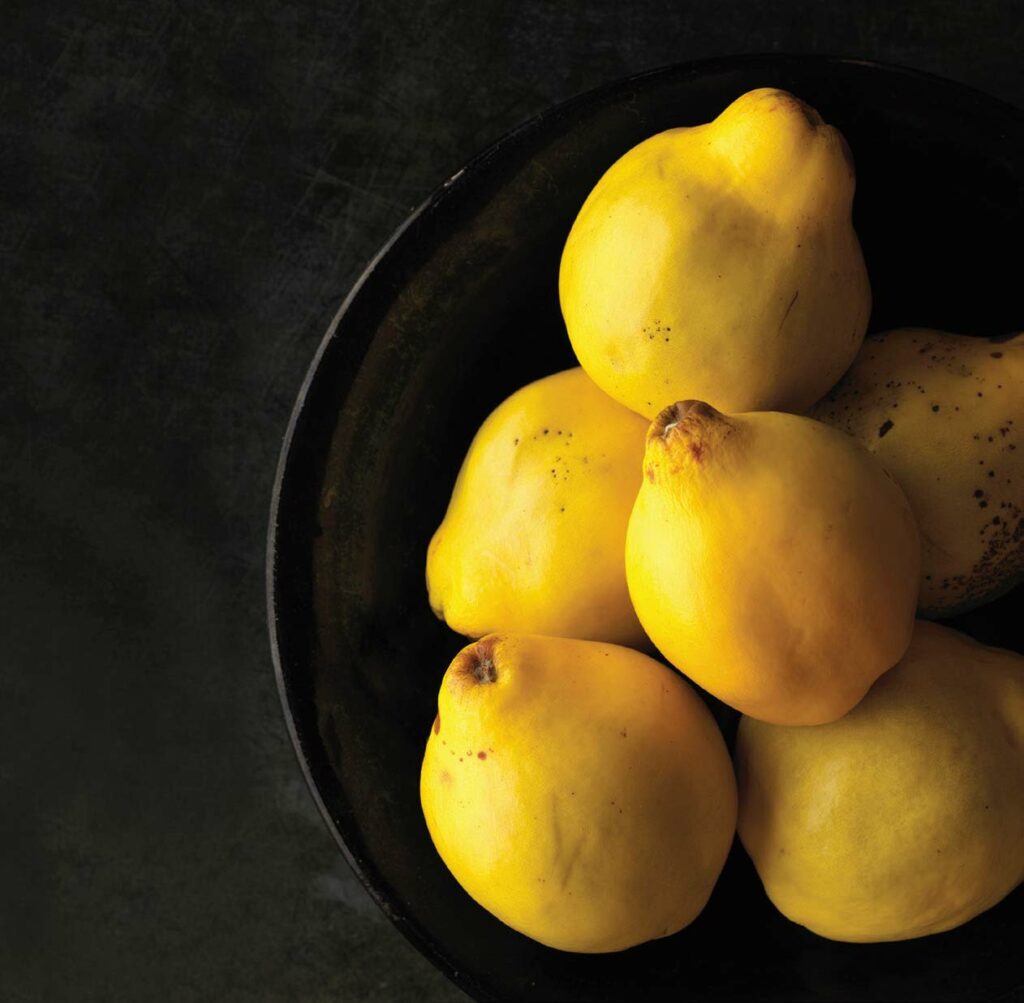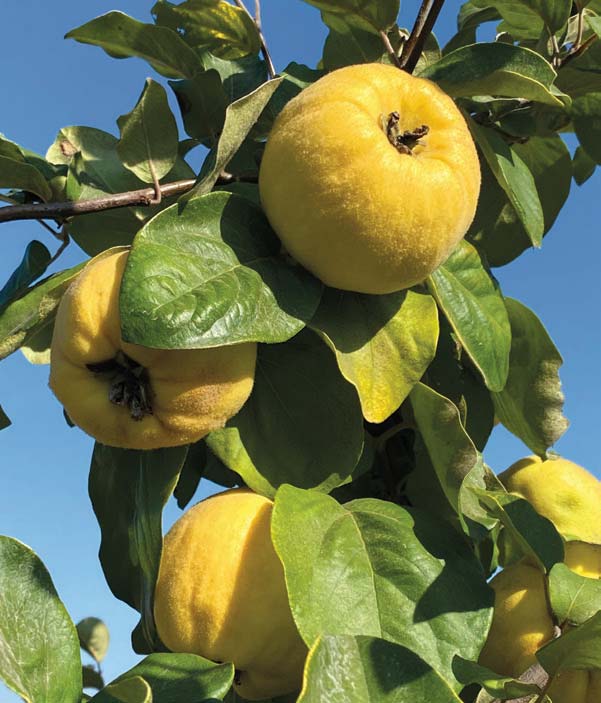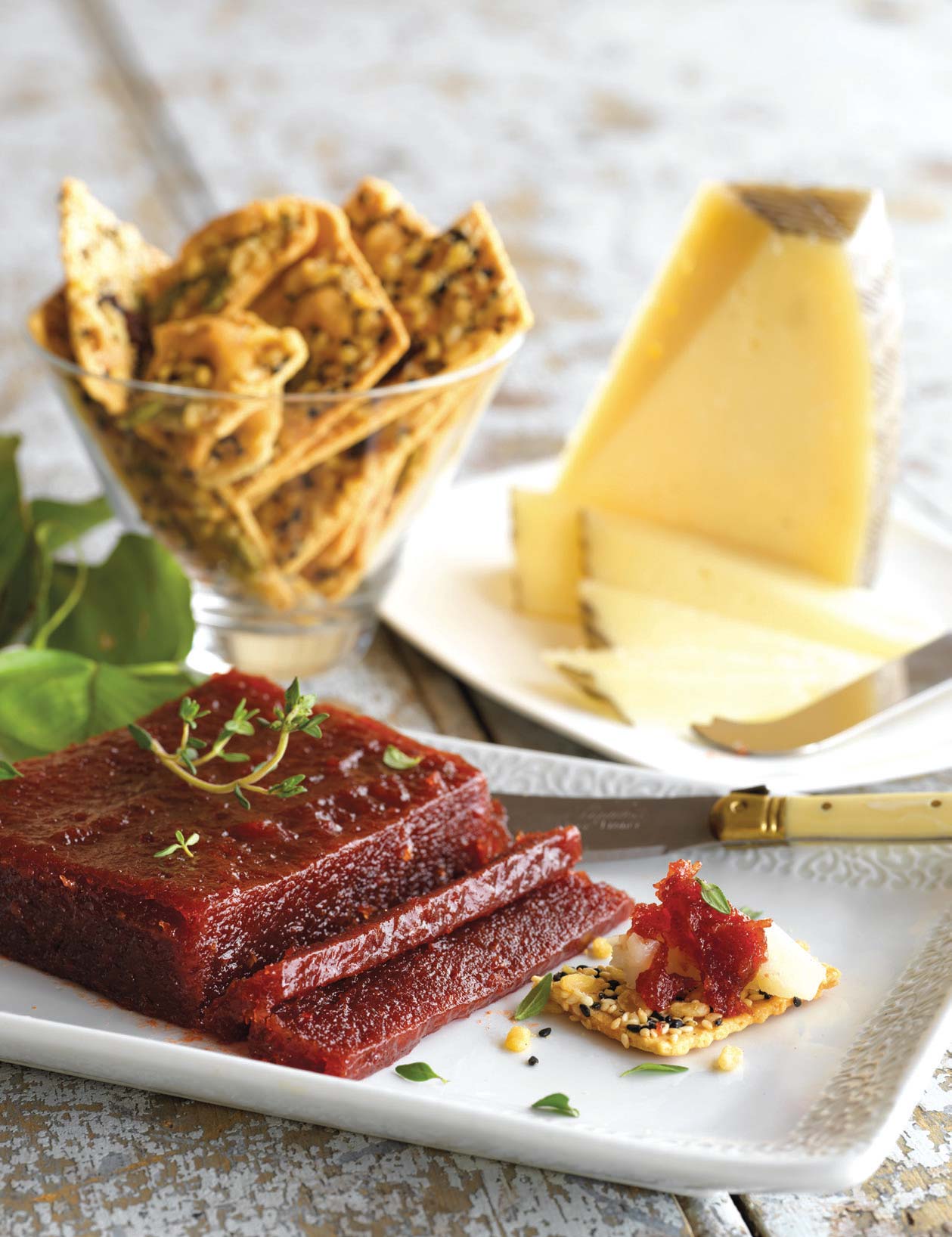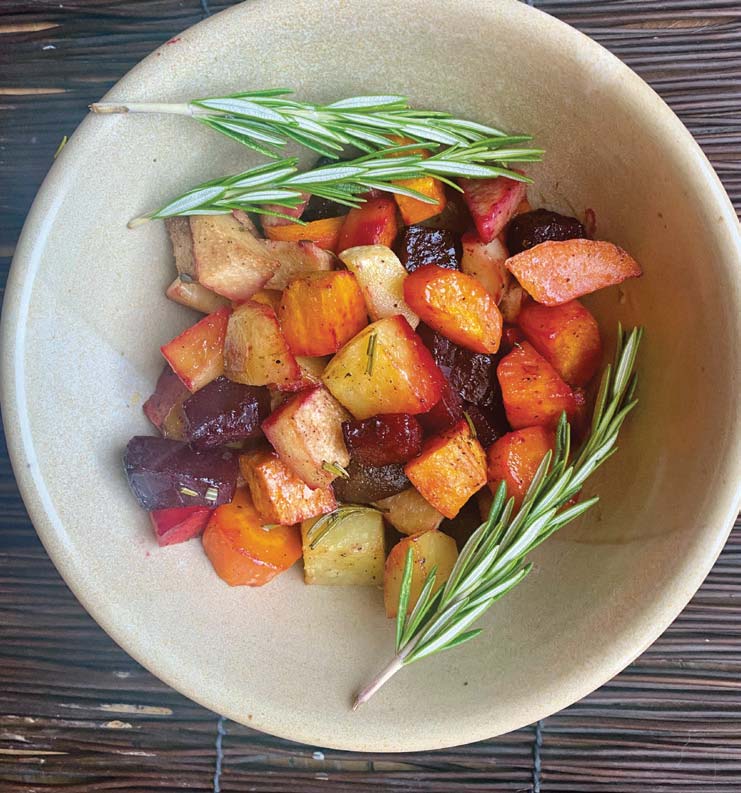
Revered for their honeyed flesh and divine fragrance, these beguiling fruits are equally at home in sweet and savory dishes
PHOTOGRAPHY BY PATRICK TREGENZA AND NADINE SCHAEFFER STYLING BY DIANE GSELL
Golden in color, uniquely fragrant, transcendently delicious when cooked, quince just may be the very best fruit you’ve never had.
A member of the rose family, quince (Cydonia oblonga) is one of the most ancient and venerated of all domesticated fruits. Quince trees are mentioned in historical records from Mesopotamia to Constantinople, dating to the Garden of Eden according to rabbinical texts. The Greeks cultivated quince trees for making preserves. The Romans considered the voluptuous fruit a perfect symbol of love and happiness, and dedicated them to the goddess, Venus.
Italian historians in the Middle Ages described far more varieties of quince than exist today. Their records document using the fruits to perfume linens, and to make a sweet, dense fruit paste that in Spain is known as membrillo. At the turn of the last century, many American and European family farms had a quince tree or two tucked into the corner of the garden.
Quince are beautiful fruits roughly the size of a softball. They glow the color of liquid sunshine when ripe and are prized for their flavor and divine fragrance. A single quince also contains enough pectin to set any batch of preserves, making this pome fruit—cousin of apples and pears—invaluable for use in other fruit jams, jellies and butters. Quince are harvested in the fall and can be stored in a root cellar or refrigerator for many months. In the cold of winter and gray, wet days of early spring, a single quince can add a touch of sweetness and taste of summertime past to any meal.
Despite its allure, quince suffers from just one flaw, which led to its near obsolescence: The tantalizing fruit generally cannot be eaten fresh. I mean, you could, but biting into a freshly picked quince generally leads to regrets. The raw fruit is usually highly astringent and rock hard. Quince must be baked, roasted or transformed into preserves to be appreciated fully; heat is the alchemy that releases their intensely perfumed, sweet and slightly spicy flavor, which has notes of citrus, pineapple and honey.
They glow the color of liquid sunshine when ripe and are prized for their flavor and divine fragrance.

CULTIVATING QUINCE
Though there is little in the way of modern books about quince, the U.S. Library of Congress retains a complete version of the 1896 publication, Quince Culture: An Illustrated Hand-Book for the Propagation and Cultivation of the Quince by William Witler Meech, which remains relevant to home orchardists today.
Quince are extremely easy to grow, fruit quickly and prolifically and can live for up to 100 years. Although they can grow up to 15 feet tall, a quince tree can be pruned to a smaller size for the backyard; I like to keep my trees at about eight feet for ease of harvesting. Quince trees are also exceptionally hardy, with great natural disease resistance and tolerance of a wide range of climate zones, soils and growing conditions. Once established, quince trees are also quite drought resistant and so hardy, they’re used as the rootstock for grafting pear trees, which are more delicate.
On the Central Coast and in the Monterey Bay region, quince trees bloom from late March to early April, and what a show they put on. The trees burst with large, delicate pale pink blossoms, which are followed by fuzzy baby fruit surrounded by woolly leaves. Bees adore the flowers, and I have discovered more than one bird’s nest tucked under the sizeable leaves. The fruit are harvested in September and October, with mature trees producing a generous 100 pounds or more of fruit. The astringency of the raw fruit also repels birds and squirrels, and most insect pests.
If you’d like to plant a quince tree in your yard, now is the time to order a tree to plant, bare root, this winter. Though there are dozens of quince varieties available to order, two deserve special mention and recommendation. The aromatnaya quince is an extremely fragrant variety from the Black Sea region of Russia and Turkey. This cultivar is tough, sturdy and produces fruit quickly after just a few years in the ground. Though I have read it can be eaten fresh, I haven’t found that to be the case and still prefer its flesh well cooked. I also recommend the Van Deman quince, which was bred by renowned American botanist Luther Burbank in the late 1800s. Supposedly, he grew out and tested 50,000 quince seedlings to select and develop this variety. This tree produces exceptionally large, golden fruit and is hardy enough to thrive in a wide range of growing conditions.
When purchasing quince trees, be sure to buy a fruiting variety and not an ornamental, as several landscaping hybrids have been bred for their stunning flowers and graceful shape, but don’t produce impressive fruit. Quince are also self-fertile, so you won’t require a second variety in your yard to produce fruit.
To plant bare root trees, find a location that gets at least six hours of sun a day, preferably more. Dig a hole twice as big as the root ball, place the new tree in it and gently backfill the remaining space with soil. Water the tree immediately after planting and apply a six-inch layer of mulch around the base, but don’t let it touch the actual trunk, as it can lead to rot or harbor insects.
If you want to constrain the height of your quince tree, cut the trunk down to two to three feet in height, which will encourage the lower branches to sprout. In early spring, apply an organic granular tree fertilizer, available at most nurseries or garden centers. Water your planting weekly if there is no rain, and for the first two years of growth, remove any flowers or fruit that form to focus the tree’s energy on building strong roots and scaffolding. By year three or four, you should be able to harvest your first fruits. They are ready to pick when they are completely gold and can be removed with an easy twist or tug.
If you don’t have a quince tree of your own, our regional farmers markets will generally have them available in fall.
QUINCE IN THE KITCHEN
Cooking with quince is a joy since they can be used in both sweet and savory dishes and are well-suited for baking, poaching and roasting. They can also be turned into jam, jelly, quince “butter” and membrillo, a famed Spanish quince paste traditionally eaten with Manchego cheese. The following recipes are two of my favorite ways to serve quince.

Spiced Membrillo
Courtesy Nadine Schaeffer
Membrillo keeps for over a month refrigerated, pairs well with any cheese and is a wonderful accompaniment to cured meats. Although most recipes usually call for just quince, sugar and lemon juice, I like to add a blend of spices to augment the flavor. You may be tempted to reduce the considerable amount of sugar in the recipe, which will yield a membrillo with a softer texture that, while not sliceable, is still quite tasty.

Roasted Quince and Root Vegetables
Courtesy Nadine Schaeffer
You can substitute any root vegetables for this recipe but in total, you should include roughly 3 pounds of produce. This roasted assemblage of earthy and fruity flavors makes for a wonderful autumnal side dish that pairs well with roasted pork or chicken. Be sure to scrub, trim and dry the root vegetables before chopping.
WHERE TO BUY
You can find quince trees at Trees of Antiquity (treesofantiquity.com), Raintree Nursery (raintreenursery.com) and One Green World (onegreenworld.com).
About the author
Nadine Schaeffer is a farmer, artist, grower of odd fruits, lover of all roses, lapsed linguist, embarrassed epicurean and inadvertent menagerie keeper living on California’s Central Coast. Birdsong Orchards is her farm in the Pajaro Valley, where she grows over 200 varieties of fruit trees and 1,000-plus roses.
- Nadine Schaefferhttps://www.ediblemontereybay.com/author/nadineschaeffer/
- Nadine Schaefferhttps://www.ediblemontereybay.com/author/nadineschaeffer/
- Nadine Schaefferhttps://www.ediblemontereybay.com/author/nadineschaeffer/
- Nadine Schaefferhttps://www.ediblemontereybay.com/author/nadineschaeffer/


